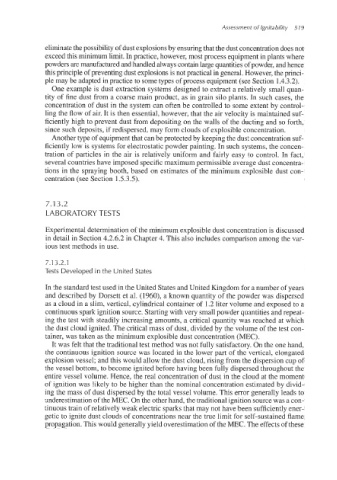Page 552 - Dust Explosions in the Process Industries
P. 552
Assessment of lgnitability 5 19
eliminatethe possibility of dust explosionsby ensuringthat the dust concentrationdoes not
exceed this minimum limit. In practice, however, most process equipment in plants where
powders are manufactured and handled always contain large quantitiesof powder, and hence
this principle of preventing dust explosions is not practical in general. However, the princi-
ple may be adapted in practice to some types of process equipment (see Section 1.4.3.2).
One example is dust extraction systems designed to extract a relatively small quan-
tity of fine dust from a coarse main product, as in grain silo plants. In such cases, the
Concentration of dust in the system can often be controlled to some extent by control-
ling the flow of air. It is then essential, however, that the air velocity is maintained suf-
ficiently high to prevent dust from depositing on the walls of the ducting and so forth,
since such deposits, if redispersed, may form clouds of explosible concentration.
Another type of equipment that can be protected by keeping the dust concentration suf-
ficiently low is systems for electrostatic powder painting. In such systems, the concen-
tration of particles in the air is relatively uniform and fairly easy to control. In fact,
several countries have imposed specific maximum permissible average dust concentra-
tions in the spraying booth, based on estimates of the minimum explosible dust con-
centration (see Section 1.5.3.5).
7.13.2
LA50RAT0RY TESTS
Experimental determinationof the minimum explosible dust concentrationis discussed
in detail in Section 4.2.6.2 in Chapter 4. This also includes comparison among the var-
ious test methods in use.
7.13.2.1
Tests Developed in the United States
In the standardtest used in the United States and United Kingdom for a number of years
and described by Dorsett et al. (1960), a known quantity of the powder was dispersed
as a cloud in a slim, vertical, cylindrical container of 1.2 liter volume and exposed to a
continuous spark ignition source. Startingwith very smallpowder quantitiesand repeat-
ing the test with steadily increasing amounts, a critical quantity was reached at which
the dust cloud ignited. The critical mass of dust, divided by the volume of the test con-
tainer, was taken as the minimum explosible dust concentration (MEC).
It was felt that the traditional test method was not fully satisfactory. On the one hand,
the continuous ignition source was located in the lower part of the vertical, elongated
explosion vessel; and this would allow the dust cloud, rising from the dispersion cup of
the vessel bottom, to become ignited before having been fully dispersed throughout the
entire vessel volume. Hence, the real concentration of dust in the cloud at the moment
of ignition was likely to be higher than the nominal concentration estimated by divid-
ing the mass of dust dispersed by the total vessel volume. This error generally leads to
underestimationof the MEC. On the otherhand, the traditional ignition source was a con-
tinuous train of relatively weak electric sparks that may not have been sufficiently ener-
getic to ignite dust clouds of concentrations near the true limit for self-sustainedflame
propagation. This would generally yield overestimation of the MEC. The effects of these

